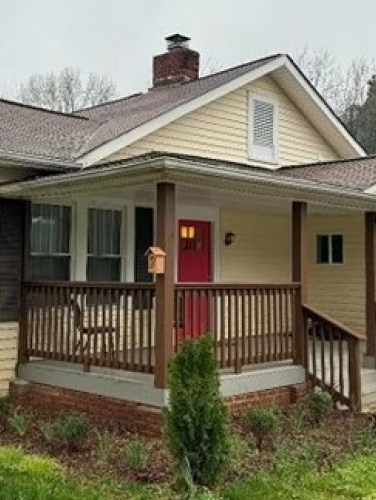
Caldwell-Bradford School
(ca. 1889-1903)
The Caldwell-Bradford School is one of Mecklenburg County’s only known surviving one-teacher schoolhouses.
16401 Davidson-Concord Rd, Huntersville, NC 28078
Public education has played a prominent role in Mecklenburg County history for more than 150 years. The county was the site of North Carolina’s first public graded school (1873), and public-school teachers were employed in north Mecklenburg County as early as 1871. The Caldwell-Bradford School is one of the county’s only known surviving one-teacher schoolhouses, an educational institution that once served students of all ages in local rural communities during the early twentieth century. It is unclear when the Caldwell-Bradford School was built, but as the property was purchased by the county board of education in 1889, it is likely that the building was constructed between that purchase and 1903, when statewide recommended schoolhouse plans – markedly different than the layout of the Caldwell-Bradford School – were issued by the North Carolina Department of Public Instruction.
Property Quick Links
The school was named for its original sponsors – the Caldwell and Bradford families – who, between them, accounted for about twenty of the school’s first students. In addition to educating the children of Huntersville’s early residents, the Caldwell-Bradford School employed as teachers women who hailed from the families of some of north Mecklenburg’s earliest settlers, families whose names are still familiar and prominent in the community a century later, including the Jetton, Knox, Cashion, Cowell, and Bradford families.
One-teacher schools like Caldwell-Bradford only served local students up to grade 6. After its opening, the Caldwell-Bradford School remained one of the county’s smallest one-teacher schools, with an average enrollment of between nineteen and twenty-one students. Because of its small size, the school was an early target for closure by the board of education when, after World War I, school consolidation was the preferred means for balancing dwindling rural populations against increasing education costs of multiple small schoolhouses. That choice became easier as transportation improvements allowed for students to be bused from greater distances to fewer but larger and more cost-effective schools.
As the school consolidation campaign intensified in the 1920s – between 1917 and 1923, the county’s twenty-eight one-teacher school count dropped to eight – the Caldwell-Bradford School was closed in October 1923. Its students were bused to Caldwell Station School or Huntersville High School. After a brief stint as a local community center, the abandoned schoolhouse was acquired by John Grier Caldwell (1894-1971) and his wife Lillie Haltiwanger Caldwell (1898-1980). They converted the structure into its current use as a residence, creating a now century-old unique example of ingenuity in the adaptive reuse of a former educational resource. After John’s death, Lillie continued living in the house until 1977. This one-time schoolhouse now continues as part of north Mecklenburg’s rapidly diminishing inventory of century-old homes.

